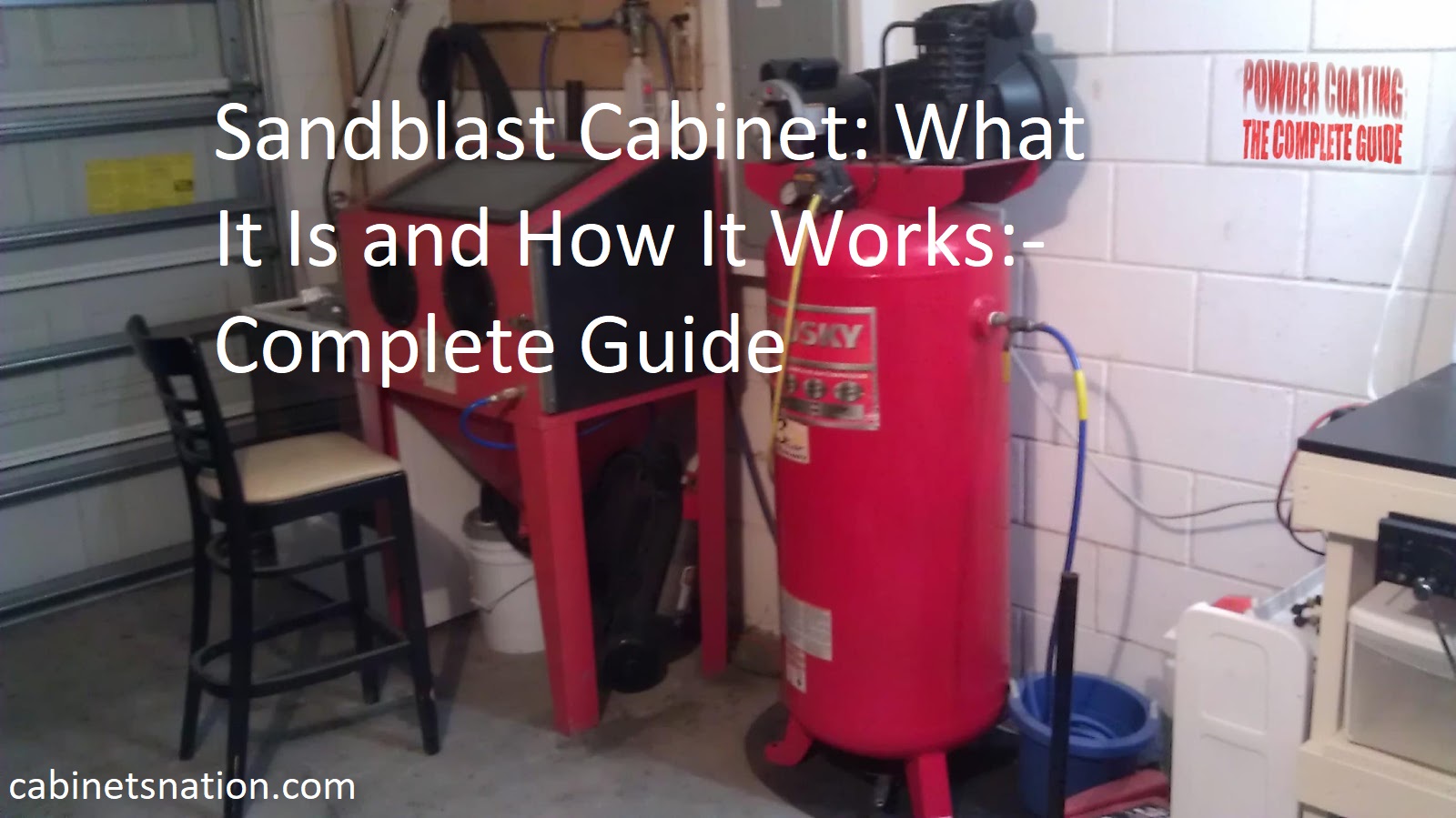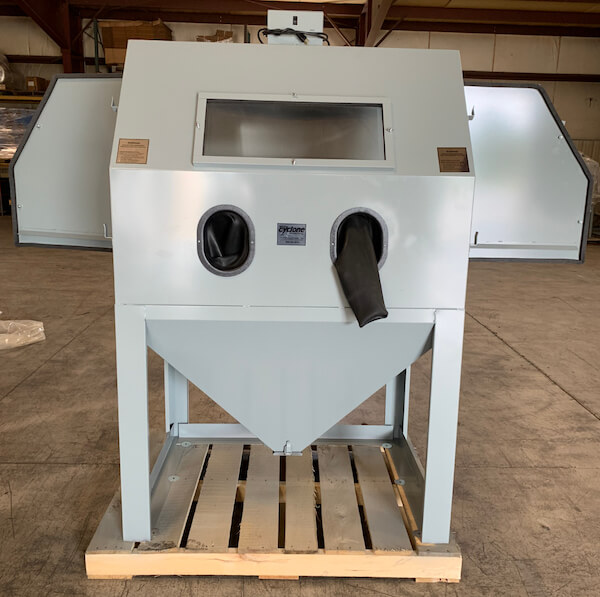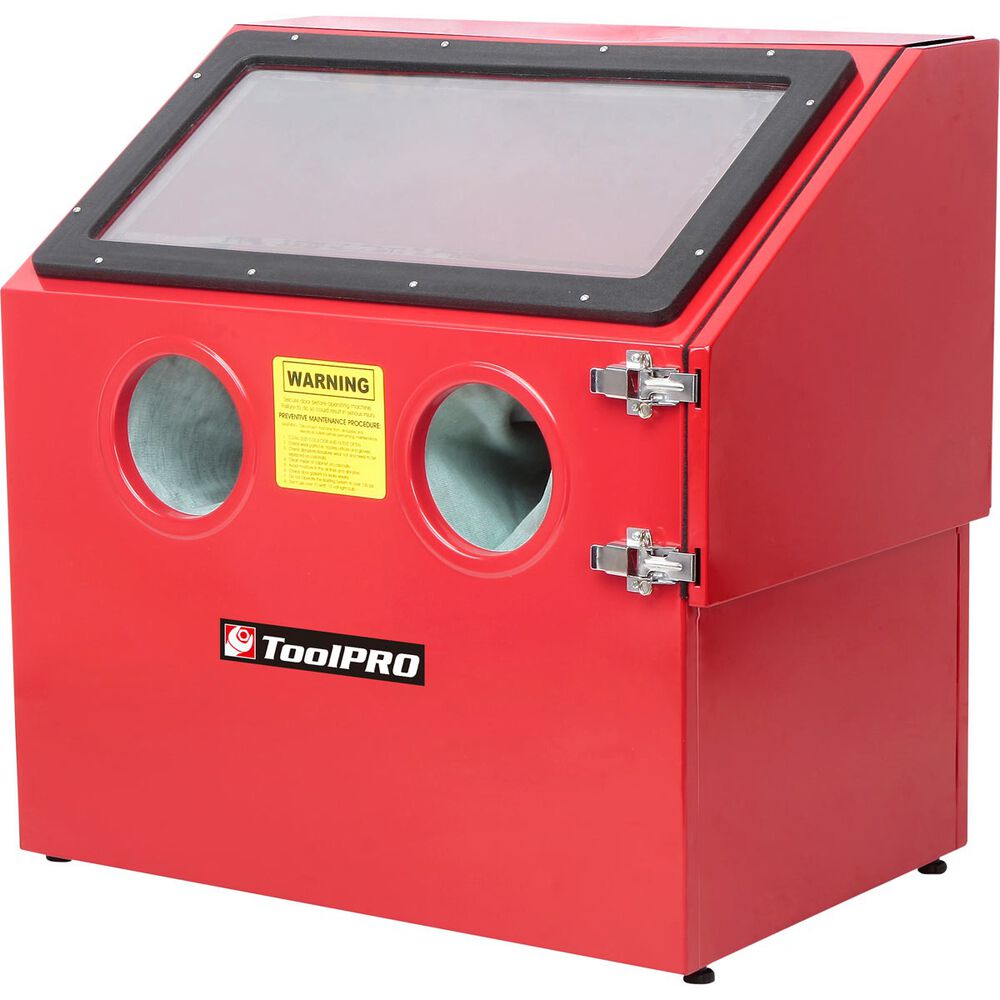Do you have plans to buy a sandblast cabinet? Then understanding its inner workings is essential. You need to know how this heavy-duty equipment works, and the difference it can make in your projects. This guide is here to help, highlighting why a sandblast cabinet offers you the best results. Get ready to learn all about it!
Sandblast cabinets, which are sometimes referred to as blasting cabinets, sandblasting, bead-blasting, or sandblaster machines, are a common pieces of equipment used in metalworking and manufacturing that can be used to etch light materials or remove metal surfaces.
Sandblast cabinets use a compressed air source and abrasive materials such as silica sand, copper slag, glass beads, aluminum oxide or steel shot (depending on the application) to clean, polish and remove surface contaminants from metal surfaces.
Sandblast cabinets are essential for many industries because they provide a safer alternative to manual cleaning. Manual cleaning of metal surfaces often involves toxic and hazardous chemicals which can be potentially dangerous for employees and the environment. Sandblast cabinets provide a cost-effective way of safely cleaning metals without using dangerous chemicals. The process is not only faster but also helps prolong the life of the product being worked on while producing desired results in regard to aesthetics and material strength.
What is a Sandblast Cabinet?
A sandblast cabinet is a pressure vessel designed to contain and pressurize abrasive media to create an air stream that can be used to remove layers of unwanted material from a variety of surfaces. It typically consists of a cabinet with an opening in the front, which is connected to a vacuum source or compressor.
In this guide, we’ll look at what each part of the sandblast cabinet does and how it works.
The vacuum source or compressor provides pressure for the abrasive media to create an air stream that is directed through the blasting nozzle and onto the work surface. The pressurized media goes through a valve at the bottom of the blaster and can be controlled by either manual adjustment or automation. This ensures that only enough pressure is being used for any given job. For example, fine ceramic particles are typically used for delicate materials while medium-grain sandpaper is better suited for metal surfaces.
The blasting nozzle is attached to an arm that allows exact control over where blasting takes place on the work surface. The sweep arm usually has adjustable speed settings so you can control how fast or slow you want your grit spraying across the material – slower speeds are often better for delicate surfaces like fiberglass or car paint. Once you have selected speed settings, you will direct the nozzle onto areas needing treatment until your desired effect has been achieved.
Sandblast cabinets also come equipped with dust collectors and filters so particles from blasted materials don’t end up in respirators of workers nearby – these would become airborne when air is introduced into compressor or vacuum systems during use. Some cabinets even include LED lighting so you can monitor progress on light-sensitive materials such as gemstones when completing intricate tasks like scene etching into glass products.
Definition of a sandblast cabinet
A sandblast cabinet is a device that uses abrasive materials to clean or remove varying degrees of surface contamination from different surfaces. The most common types of surface cleaning and removal processes that are conducted in a sandblast cabinet involve the use of pressurized air and abrasive materials to clear away rust, scale, paint, and other deposits found on metal or hard surfaces. Sandblasting cabinets are widely used in industrial settings such as automotive garages, machine shops, manufacturing facilities, and other places where metalworking and surface treatments take place.
Essentially, the process involves pushing a mixture of air and an abrasive material against the surface being treated at a considerable force. This process fractures the foreign material on the surface which is then removed with an auxiliary flow of pressurized air. After treatment has been completed the treated area is then rinsed off with water to help remove anything that remained after blasting took place; this rinsing helps prepare it for final finishing operations such as painting or refinishing.
Different types of sandblast cabinets
Sandblast cabinets are useful tools for removing paint, rust and other contaminants from a variety of surfaces. While the design and size of these cabinets can vary, most use a combination of compressed air and an abrasive material to clean surfaces. They come in several different types that range from hobbyist models suitable for small workshop or garage use to large industrial units used by professional painters and refinishers.
Abrasive blasting cabinets are often classified by the type of media they can employ. Common types include:
-Sandblast cabinets: These look most like traditional sandblasting equipment, with a hood attached to the cabinet for two operators. They feature a dust collection system, variable pressure controls and an enclosed chamber for safety. Sandblast cabnients use dry abrasives like sand, garnet or aluminum oxide to clean surfaces with minimal mess.
-Carbide blast Cabinets: Similar in operation to sandblast cabinents, these specialized cabinets are designed specifically for cleaning extra-tough materials such as tungsten carbide, titanium alloys and stainless steel using dense media such as crushed glass or fine walnut shells as the abrasive material.
-Solvent blast cabinets: Also known as slurry blasting cabinets, these devices use solvents like chemical cleaners or soaps along with water in a closed system containing fine particles of abrasive media to remove stubborn deposits from surfaces.
-Soda blast Cabinets: Using sodium bicarbonate (baking soda) instead of more traditional grits or media for cleaning power is the hallmark of this type cabinet. Soda blasting is now preferred over other methods due to its superior non-abrasive nature; it safely strips off paint and leaves behind a smooth finish while also reducing dust build up in confined spaces; making it ideal for many applications such as auto body repair work where dust control is essential or when slick finishes are desired on wood furniture pieces without marring their surface with traditional harsh blasting methods.
How Does a Sandblast Cabinet Work?
A sandblast cabinet is a personal protective equipment item of safety gear that is used to contain airborne particles and debris during sandblasting operations. Sandblasting helps remove surface contaminants from a variety of materials, including metal and plastic.
The primary components of a sandblast cabinet are the cabinet itself, the abrasive delivery system, the blast gun and hose assembly, the dust collector, and the exhaust ventilation system. The cabinet acts as an “isolator” between the person performing sandblasting operations and the person subject to any large particles or excessive noise.
The abrasive delivery system is responsible for introducing new abrasive into the blast cabinet, while the blast gun and hose assembly is responsible for delivering media onto a work surface via an extension into the blasting chamber. A powerful suction force provided by a dust collector pulls any debris or excess material away from the user’s face while recycling any reusable pelletized abrasives back into an enclosed hopper unit within the blasting chamber. Lastly, specialized air filters help capture gas vapors or exhaust as well as keep protective eyewear clear from contaminants that could impair sight.

Explanation of the sandblasting process
Sandblasting is a process that uses compressed air to propel abrasive particles such as silicon carbide, aluminum oxide, or glass beads at high speed onto a surface to achieve various goals such as etching, smoothing or cleaning.
Sandblasting cabinets are specially designed enclosed chambers equipped with doors and protective gloves that allow a worker to position the surfaces to be blasted in front of the blasting nozzle. The blasting media used is contained within the cabinet for protection and containment purposes.
Once the surface has been placed inside the cabinet and sealed off from environmental hazards, the door is closed and pressurized airflow from an elevated pressure feed unit delivers an even coating of abrasive media over the surface. This process removes dirt, debris, corrosion and other unwanted material from surfaces.
How a sandblast cabinet functions
A sandblast cabinet is a self-contained work space designed to contain and contain pressurized abrasive materials. The material, typically sand or other mineral-based substances, is propelled under high air pressure to the surface of an object in order to remove contaminants. The abrasive particles then recycle inside the cabinet, where they are reused until the blast operation is completed. A tight seal between the chamber and the internal wall of the cabinet prevents contamination from entering or escaping.
Sandblast cabinets are used in industrial and automotive settings primarily for cleaning or refinishing parts that may have corrosion or another defect. During a sandblasting process, a mixture of air pressure and abrasives is applied to a part in order to achieve three primary goals: removing buildup, smoothing surfaces, and reshaping pieces into desired sizes and shapes. Sandblasting can also be used on glass surfaces such as windows to engrave decorative elements into them.
Due to its powerful cleaning capabilities, sandblasting offers several advantages over conventional cleaning methods such as hand scraping or soap-and-water scrubbing. By streamlining processes like restoring old materials or preparing new ones for further refinishing processes like painting, powder coating or welding, sandblasters can help optimize time savings for businesses in these industries.
Advantages of Using a Sandblast Cabinet
The use of a sandblast cabinet is beneficial in a wide variety of different tasks. For example, automotive and metalworking tasks, like cleaning rusty and corroded parts, provide excellent results since the abrasive action strips away contaminants with precision. The use of sandblasting enables you to find tough areas that may be difficult to reach as well as remove stubborn paint particles and other debris without damage or excessive wear-and-tear to the base material.
Compared to many other methods for surface cleaning such as using solvents or carbon dioxide, sandblasting leaves a much cleaner finish in less time with minimal effort required from the user. Also, when compared to manual labor that necessitates greater time investment and physical efforts, sandblasting can help complete automotive projects quicker while achieving results with reduced cost. Moreover, whereas the use of chemical solvents can release noxious fumes into the atmosphere, sandblasting produces no hazardous byproducts since it utilizes only solid materials like quartz sand and aluminum oxide. Additionally, utilizing a roomy cabinet helps reduce dust exposure during operations because it protects workers from exposure to fine airborne particles which could otherwise worsen indoor air quality due air pollution regulations.
In summary, sandblasting cabinets offer a number of advantages when used in comparison to traditional methods such as using solvents or manual labor for cleaning surfaces or removing paint residues and rust particles from metal elements. They save time yet remain cost-effective solutions for achieving uniform results with precision without releasing any harmful byproducts into the atmosphere for superior safety and risk management outcomes.
Benefits of using a sandblast cabinet over other sandblasting methods
Sandblast cabinets provide an effective and efficient method of removing contaminants from metal objects. Compared to other sandblasting techniques, there are many advantages to using a sandblast cabinet.
The first advantage is safety. Without having to worry about flying debris or dust clouds, sandblasting with a cabinet can be performed indoors, in a confined space. This provides an extra layer of protection for operators and ensures that any hazardous material is kept in one place and does not spread around the workspace. Additionally, noise levels are significantly less in a closed chamber than they would be with outdoor blasting methods.
In addition to being safer than other methods, using a sandblast cabinet also offers several performance features which can improve the quality of your final product:
- Higher velocity: The air pressure and nozzles used inside the cabinet allow for higher velocities, ensuring that contaminant particles are scrubbed away efficiently and completely removed from the surface of the object being blasted.
- Less stress on components: With an enclosed blasting environment, parts can be subjected to different levels of force as needed without fear of them suffering damage due to overabrasion or uneven pressure distribution on their surfaces.
- Consistent results: Since all components are exposed to the same blast forces inside the cabinet, users can expect a consistent finish on every part — eliminating any variability caused by external conditions like wind speed or dust clouds outside in open air blasting setups.
- Efficient cleaning process: Sandblast cabinets allow for adjustable pressure settings so operators don’t have to deal with wasted overspray or inconsistent coverage when working on multiples surfaces at once — saving time by reducing unnecessary stopgaps between clening cycles.
The combination of these features means that even complex jobs will be completed quickly and safely with excellent results every time when working with a sandblast cabinet system instead of traditional abrasive cleaning techniques outdoors.
Cost-effectiveness of sandblast cabinets
Sandblast cabinets offer users a cost-effective solution for cleaning and stripping surfaces quickly, efficiently, and safely. Compared to manual processes like wire brushing or sanding, sandblast cabinets allow for the cleaning of parts at a faster rate with less effort. Additionally, because no human contact is required with the object being treated—saving time and eliminating worker fatigue—the process can be done more effectively without sacrificing quality control.
Moreover, sandblast cabinets offer fewer materials costs when compared to other methods by using recycled, reusable abrasive media instead of expensive replacement belts or pads used in other methods. This means that less frequent replenishment of materials is necessary and budget concerns are greatly reduced. Specialized blast-cleaning specialists may be on hand to help in selecting the right materials for your particular requirements.
Safety is an added benefit when using sandblast cabinets because they maintain confined dust and particles that might otherwise harm someone nearby. Also, the suctioning effect created by most blast cabinets prevents environmental dust contamination from entering workplace areas or entering into ventilation systems. In addition, minimal dust escape reduces the need for exhaust fans thereby saving energy costs related to their operation as well as controlling noise pollution from their use within commercial spaces.
Choosing the Right Sandblast Cabinet
When it comes to choosing the right sandblast cabinet for your needs, there are many factors to consider. Size is an important factor to consider as you will want a cabinet big enough for the size of parts that you need to sandblast. Additionally, some cabinets may offer more features than other cabinets for an explosive-proof environment or extra safety features that vary significantly between manufacturers.
The type of media being used is also a factor in picking the right sandblast cabinet – some materials require different blasting media while others need more abrasive materials compared to others in order to provide a smooth finish. Finally, personal preference is important when selecting the right blast cabinet as they often come with ergonomic features and colors that contribute to comfort and user experience.
Factors to consider when choosing a sandblast cabinet
Sandblasting is a popular technique for removing old paint, rust, or dirt from a variety of surfaces. It is often used on metal and wood components. For the best results, it is important to choose the right sandblasting equipment and supplies.
When looking at the different types of sandblast cabinets, there are several factors to consider. The size of your work area will play an important role in determining the right sandblast cabinet. Smaller cabinets may be more suitable for limited spaces while larger models can handle larger-scale projects with ease. Additionally, you should consider the type of material that you will be working with when selecting a sandblast cabinet. Some materials require more intensive blasting than others, so selecting one that is powerful enough is essential to get the job done right.
User convenience should also factor into your decision when choosing a sandblast cabinet. Do you need an enclosed cabinet or can an open-air model suffice? If possible, try out various models to ensure that your chosen cabinet offers adequate comfort for your needs as many blasting projects can take several hours or longer to complete. Lastly, cost effectiveness needs to be taken into account when considering purchasing a sandblast cabinet—make sure that it fits within your budget and meets both your quality and performance expectations prior to making an investment in any type of blasting system!
Key features to look for in a sandblast cabinet
A sandblast cabinet is an enclosed workspace used to sand or grit-blast clean household items, metal parts, jewelry-making supplies and other materials. High-quality cabinets are designed for efficient sand blast cleaning and will serve you for years in a variety of applications. When shopping for a sandblast cabinet, there are a few key features to consider that help enhance performance and achieve superior results.
One feature to look for in a sandblast cabinet is the dust collection system which is designed to reduce air contamination from blasted particles and debris. In general, higher quality machines will come equipped with HEPA filters that can remove 99.997% of the particles passing through at 0.3 microns or greater, offering better dust separation, superior filtering and longer filter life. Another important consideration is the blasting nozzle setup on the machine which will determine how precisely sandblasting media travels toward your items being cleaned. A slanted top design will help ensure an optimal angle when blasting which leads to even blasting across different surfaces, while an ergonomic handle increases accessibility and control as you blast items.
A viewing window with LED lighting can also greatly improve visibility inside the blasting chamber while providing ample style and protection during operation. For added convenience, look for models with hinged doors that open wide enough to accommodate bulky pieces and double rubber seals that provide leak-proof performance during operation.
Conclusion
In conclusion, sandblasting is a very useful technique for various industrial applications. It quickly and easily removes rust, paint or other coatings from metal surfaces and can be used to clean a variety of different shapes, sizes and types of metal. Sandblasting cabinets allow you to control how much abrasive material is used and how deep the blasting effect is. As a result, they are a great way to safely and conveniently perform the process without having to worry about any unintended consequences or damages.
Always remember to use the proper safety equipment when using any type of sandblasting tools or machinery including the cabinet, air compressor or blaster gun. Doing so will ensure that your job goes as smoothly as possible with no unexpected results or damages.
FAQ’s
How does sandblast cabinet work?
A sandblast cabinet works by forcing abrasive media, such as sand, through a nozzle at high pressure to remove surface materials from the targeted surface. The media is contained within the cabinet, protecting the user and the surrounding environment from hazardous particles.
What is sandblasting and how does it work?
Sandblasting is a process where abrasive particles (typically sand, glass beads, aluminum oxide, etc.) are shot out of a pressure gun onto a surface to smooth or roughen it, remove contaminants, or otherwise alter the surface. It works by using highly compressed air to propel the abrasive material onto the target surface to be worked on.
What is the use of blast cabinet?
A blast cabinet is used to blast away surface contaminants from parts or components using abrasive blasting, like sand or glass beads. The blast cabinet also helps contain airborne dust, potentially hazardous abrasive particles, and noise generated by the abrasive media.
What is sandblaster process?
Sandblasting is a mechanical process of treating a surface with an abrasive material to remove paint, dirt, rust, or coatings from a variety of materials, often metal. It is also used to create a textured surface or to shape a part in the manufacturing process.
Why use a sandblaster cabinet?
A sandblaster cabinet is a specialized tool used to precisely and evenly sandblast large surfaces. It is used to clean, strip and refinish metal, stone, ceramic and other hard surfaces. It is also used for removing rust, paint and other coatings for artwork, tile etching and other specialized applications.
What are the benefits of sandblasting?
The primary benefit of sandblasting is that it can effectively remove unwanted material from a variety of surfaces. It can also be used to clean and roughen surfaces, apply a certain texture, and help to create a more ideal surface for applying paints and coatings. Additionally, it is capable of quickly cleaning large surfaces, reducing the amount of time needed for preparing and finishing a project.
Why does sandblasting remove rust?
Sandblasting removes rust by using an abrasive material, such as sand, which is propelled at high speed against the rust-affected surface. The sand particles act as a grinding agent, removing the rust layer and exposing the underlying clean metal.
What is sandblasting process in metal?
Sandblasting is a process in which metal surfaces are treated with high pressure blasts of abrasive material to remove rust, corrosion, old paint, or other material. It is an effective way to prepare metals for painting or other treatments.
What material is used for sandblasting?
Sand material is typically used for sandblasting.
What is the disadvantage of sandblasting?
The main disadvantage of sandblasting is that it can cause health problems from inhalation of the dust it generates, which can contain silica particles which can lead to silicosis. Additionally, the loud noise associated with sandblasting can cause hearing damage.
See more-
- Best medicine cabinet 2023
- Best outdoor storage cabinet 2023
- Best under cabinet lighting battery 2023
- Best cabinet liners 2023
- Best file cabinet for home office 2023


